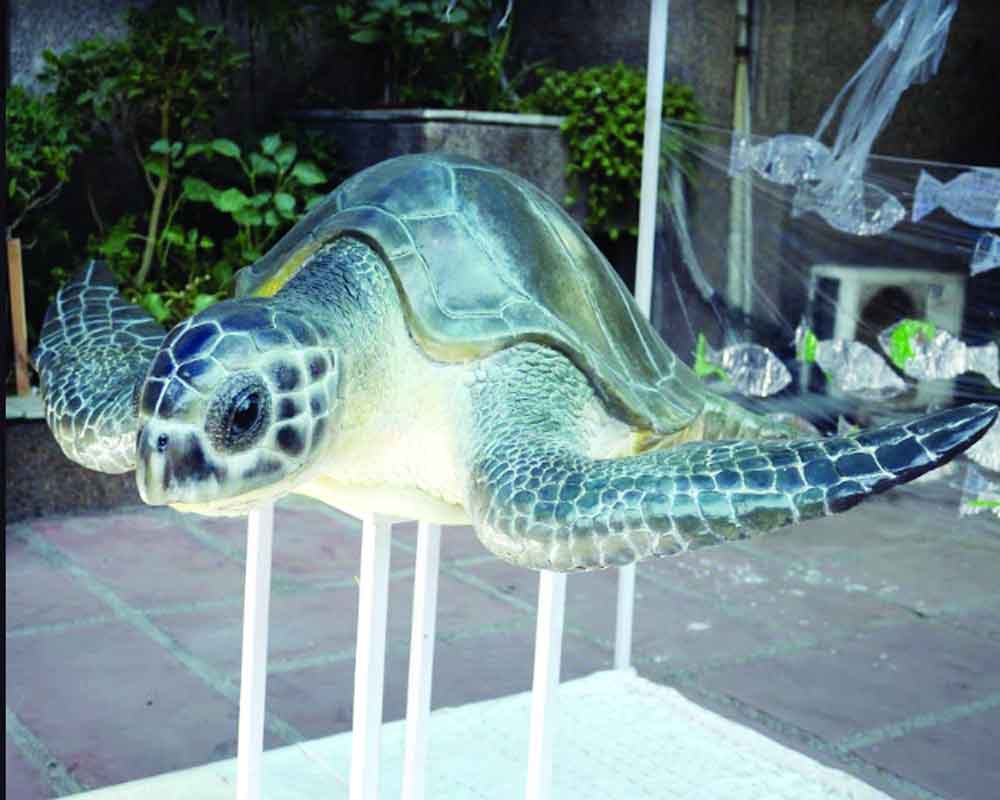Arribada, a travelling exhibition, aims to present the history, culture, biology and conservation of sea turtles, drawing attention to the numerous threats through which thousands of them are washed ashore during mass nesting. By Chahak Mittal
Emerging from the sea, they clamber up the beach for a brief period, dig nesting holes in the sand, lay eggs en masse and then vanish into the oceans as mysteriously and suddenly as they had first appeared. Some 45 to 60 days later, the hatchlings emerge and make their way uncannily towards the sea, hazarding predators and poachers.
Capturing the attention of both biologists and laymen, being a part of various mythologies and cultures across the world, attracted by the astonishing ability of these beings to migrate across oceans and dive thousands of feet deep, as well as other remarkable features of their lives, sea turtles have become a common fascination for artists as well. A travelling exhibition, Arribada: A gathering of stories, cultures and interactions with sea turtles by WWF-India, in collaboration with Dakshin Foundation and visual artist Aradhana Seth, has drawn attention to the conservation of Ridleys on the Indian coasts (listed as endangered species under the Wildlife Protection Act 1972 and CITES). The focus is on their mass nesting phenomenon, in which thousands of sea turtles are washed ashore and killed. These include the green, hawksbill, leatherback and Olive Ridleys, which are the smallest in size.
The idea of exhibition germinated when Kartik Shanker, ecologist, who has been working closely for the cause, and founder of Dakshin Foundation, and Aradhana met each other at a formal meeting a few years ago in Goa. It’s when they had discussed about their mutual fascination for turtles and their personal turtle collections that they thought of collaborating on an awareness project. At another meeting with Sejal Worah, programme director at WWF-India, the duo decided to collaborate with her too as they connected to her for the same reason as them — turtle fascination and collection. Arribada, a Spanish term for mass nesting, tells the story of sea turtles by turtle-inspired artefact collections of the three conservationists and collectors.
Kartik says that linking a cause to art makes it more recognisable in the public eye: “Such natural rhythms are mostly thought about at very isolated places and considered a subject of reading or documentaries. But when we showcase them through art curations, symbols, cultures and stories, they might grab more attention and make an impact. Science or words don’t work everytime, illustrations can help too.”
The exhibition, through a set of around 24 to 25 boxes, presents stories of conservation, history, culture, biology and people associated with turtle research in the country with each box. Aradhana, who lends the exhibition its visual language, has used recyclable material and discarded single-use plastic in the construction of artefacts. The exhibition, which is at present in the city, will travel next to Bengaluru, followed by Goa. Kartik tells us, “It brings out stories of both hindering and reverence, ecology and conservation. And of some of our own turtle heroes. As a charismatic species, they are ambassadors for their ecosystems, bringing attention to the need for conservation efforts for seascapes across the country and the world. And we aim to represent just that.”
The Olive Ridleys are the only species exhibiting the phenomenon of mass nesting in India and their habitat in India is globally the largest rookery. Apart from poaching for trade or consumption, there are various other acts and practices that indirectly threaten these species. There are threats from fisheries, bycatch mortality, coastal developments which lead to a loss of boundaries for nesting at beaches, climate change which alters their habitats and marine debris, which includes ingestions, entrapment and infiltration in food chain.
As these turtles undertake a long distance migration from the offshore waters of Sri Lanka via Tamil Nadu and Andhra Pradesh to nest in large numbers along the beaches of Odisha, there have been numerous turtle walks in Chennai for over a decade now. Recently, there has been a ban on coastal activities at Odisha’s Gahirmatha Marine Sanctuary in Kendrapara. However, following various violations, the authorities have arrested over 730 fishermen and seized around 90 boats. However, Kartik says that it is important to also recognise and differentiate between those fishermen who intentionally arrive for trade or consumption of the nesting turtles and those who don’t. “Sometimes they also target the wrong community, who are actually not responsible for killing turtles or indulge in poaching. There are also other problems that majorly contribute to this — lessening of boundaries. Turtles mainly hatch at only five to six kilometres away from the coastline and sometimes many coastal developments lead to a loss of these boundaries. They also need to be constructed the right way.”
Talking about the exhibition, Ravi Singh, secretary general and CEO, WWF-India, says, “We have been engaging with school children for over four decades now to build young leaders of conservation through programmes and initiatives that are both educational and engaging and interactive. The arribada is an attempt to take children and others into the world of turtles and marine biodiversity and highlight the need for their conservation.”


























